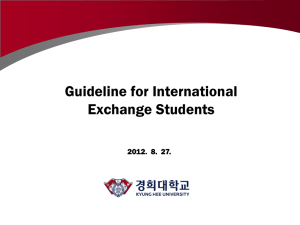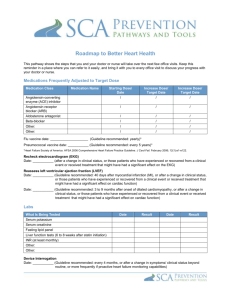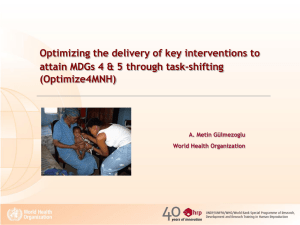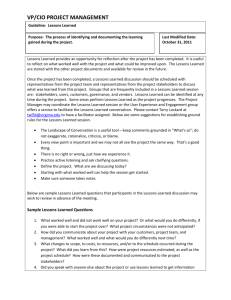Water proposed changes for the public consultation
advertisement
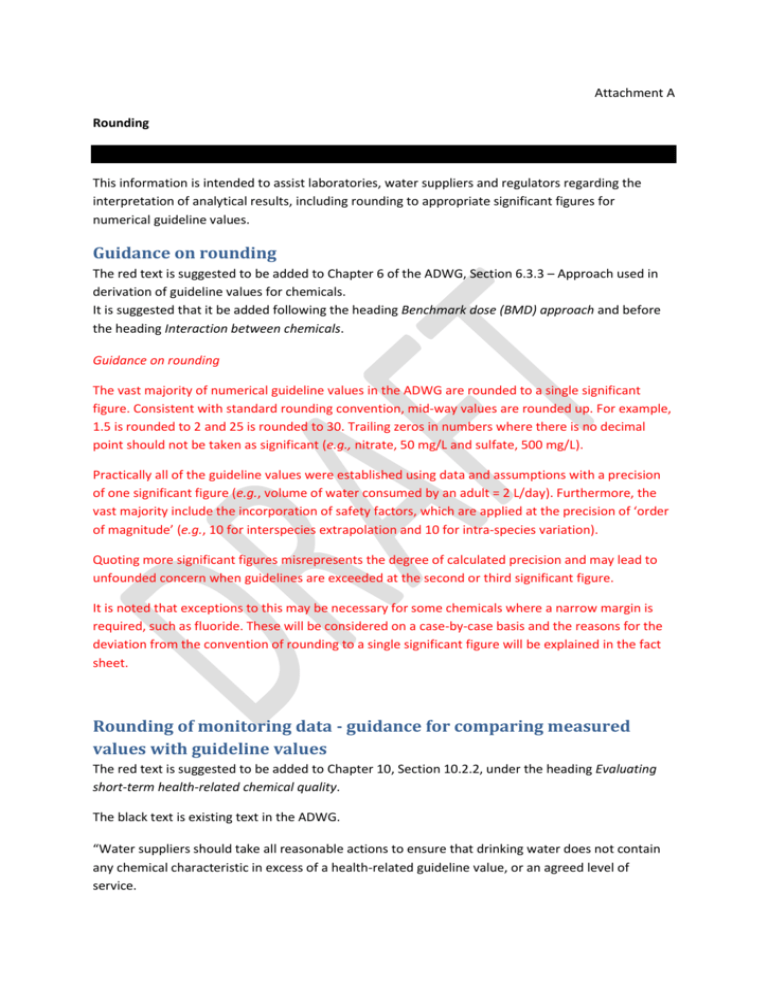
Attachment A Rounding This information is intended to assist laboratories, water suppliers and regulators regarding the interpretation of analytical results, including rounding to appropriate significant figures for numerical guideline values. Guidance on rounding The red text is suggested to be added to Chapter 6 of the ADWG, Section 6.3.3 – Approach used in derivation of guideline values for chemicals. It is suggested that it be added following the heading Benchmark dose (BMD) approach and before the heading Interaction between chemicals. Guidance on rounding The vast majority of numerical guideline values in the ADWG are rounded to a single significant figure. Consistent with standard rounding convention, mid-way values are rounded up. For example, 1.5 is rounded to 2 and 25 is rounded to 30. Trailing zeros in numbers where there is no decimal point should not be taken as significant (e.g., nitrate, 50 mg/L and sulfate, 500 mg/L). Practically all of the guideline values were established using data and assumptions with a precision of one significant figure (e.g., volume of water consumed by an adult = 2 L/day). Furthermore, the vast majority include the incorporation of safety factors, which are applied at the precision of ‘order of magnitude’ (e.g., 10 for interspecies extrapolation and 10 for intra-species variation). Quoting more significant figures misrepresents the degree of calculated precision and may lead to unfounded concern when guidelines are exceeded at the second or third significant figure. It is noted that exceptions to this may be necessary for some chemicals where a narrow margin is required, such as fluoride. These will be considered on a case-by-case basis and the reasons for the deviation from the convention of rounding to a single significant figure will be explained in the fact sheet. Rounding of monitoring data - guidance for comparing measured values with guideline values The red text is suggested to be added to Chapter 10, Section 10.2.2, under the heading Evaluating short-term health-related chemical quality. The black text is existing text in the ADWG. “Water suppliers should take all reasonable actions to ensure that drinking water does not contain any chemical characteristic in excess of a health-related guideline value, or an agreed level of service. As described in Chapter 6, guideline values in the ADWG are generally rounded to a single significant figure. When interpreting monitoring results, water regulators and suppliers need to be aware that the guideline values are the results of rounding, and that the level of precision is one significant figure. When comparing a monitoring result with the guideline value the comparison may occur at the level of one significant figure. In determining compliance, state and territory water regulators can provide guidance. Table 10.3 – Examples of comparing monitoring data to guideline values Guideline value 2 mg/L 1 mg/L 1 mg/L 500 mg/L Monitoring data Single significant figure of monitoring data 1.6 mg/L 2 mg/L 1.4 mg/L 1 mg/L 1.5 mg/L 2 mg/L 547 mg/L 500 mg/L Consequence Does not exceed guideline. Does not exceed guideline. Exceeds guideline. Does not exceed guideline. With a few exceptions (e.g. nitrate, copper, sulphate, fluoride), all health-related guideline values relate to lifetime exposure…” Rounding of monitoring data - guidance for comparing measured values with guideline values The red text is suggested to be added to Chapter 10, Section 10.3.2, under the heading Review of health-related chemical monitoring within the distribution system. The black text is existing text in the ADWG. “The reporting statistics should not include results derived from repeat samples, or from emergency or investigative samples undertaken in response to an elevated result. Monitoring data that are to be averaged or otherwise numerically adjusted should not be rounded prior to averaging or other manipulations. Comparing monitoring data with a guideline value is described in Table 10.3, Section 10.2.2. Any investigations and corrective actions arising from individual results that exceed a health-related guideline value should…” Parent compounds and metabolites, and use of screening assays This text is proposed for inclusion in Chapter 6 of the ADWG, under heading 6.3.3 – Approach used in derivation of guideline values for chemicals, following the last subheading ’Interaction between chemicals’. Guidance on parent compounds and environmental transformation products Fact Sheets and health-based guideline values are established for the form(s) of the chemical that may be present in drinking water. Where the chemical form present in drinking water is an environmental transformation product, toxicological data on the transformation product(s) should be evaluated to derive a health-based guideline value. Use of screening assays For some chemicals, the accepted analytical method is a screening assay that is able to detect any of a group of chemicals, with the measured value derived from the members of the group that are present. In analytical chemistry, a residue method involves breaking down the sample and measuring a breakdown product (for example, subjecting the sample to acid digestion and measuring carbon disulphide, CS2). Some bioanalytical methods detect groups of chemicals based on their biological activity, for example estrogenic compounds. Using such methods, it may not be possible to determine the parent compound(s) present in the original sample. In this case, it should be assumed that the result arises from the most toxic parent compound that may be present, or follow-up analytical techniques should be applied that measure the chemical of interest directly.



